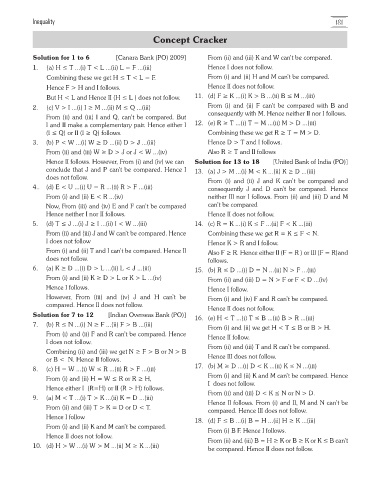Page 185 - Services Selection Board (SSB) Interviews
P. 185
Inequality 181
Concept Cracker
Solution for 1 to 6 [Canara Bank (PO) 2009] From (ii) and (iii) K and W can’t be compared.
1. (a) H ≤ T ...(i) T < L ...(ii) L = F ...(iii) Hence I does not follow.
Combining these we get H ≤ T < L = F. From (i) and (ii) H and M can’t be compared.
Hence F > H and I follows. Hence II does not follow.
But H < L and Hence II (H ≤ L ) does not follow. 11. (d) F ≥ K ...(i) K > B ...(ii) B ≤ M ...(iii)
2. (c) V > I ...(i) I ≥ M ...(ii) M ≤ Q ...(iii) From (i) and (ii) F can’t be compared with B and
From (ii) and (iii) I and Q, can’t be compared. But consequently with M. Hence neither II nor I follows.
I and II make a complementary pair. Hence either I 12. (e) R ≥ T ...(i) T = M ...(ii) M > D ...(iii)
(I ≤ Q) or II (I ≥ Q) follows. Combining these we get R ≥ T = M > D.
3. (b) P < W ...(i) W ≥ D ...(ii) D > J ...(iii) Hence D > T and I follows.
From (ii) and (iii) W ≥ D > J or J < W ...(iv) Also R ≥ T and II follows
Hence II follows. However, From (i) and (iv) we can Solution for 13 to 18 [United Bank of India (PO)]
conclude that J and P can’t be compared. Hence I 13. (a) J > M ...(i) M < K ...(ii) K ≥ D ...(iii)
does not follow. From (i) and (ii) J and K can’t be compared and
4.. (d) E < U ...(i) U = R ...(ii) R > F ...(iii) consequently J and D can’t be compared. Hence
From (i) and (ii) E < R ...(iv) neither III nor I follows. From (ii) and (iii) D and M
Now, From (iii) and (iv) E and F can’t be compared can’t be compared
Hence neither I nor II follows. Hence II does not follow.
5. (d) T ≤ J ...(i) J ≥ I ...(ii) I < W ...(iii) 14. (c) R = K ...(i) K ≤ F ...(ii) F < K ...(iii)
From (ii) and (iii) J and W can’t be compared. Hence Combining these we get R = K ≤ F < N.
I does not follow Hence K > R and I follow.
From (i) and (ii) T and I can’t be compared. Hence II Also F ≥ R. Hence either II (F = R ) or III (F = R)and
does not follow. follows.
6. (a) K ≥ D ...(i) D > L ...(ii) L < J ...(iii) 15. (b) R ≤ D ...(i) D = N ...(ii) N > F ...(iii)
From (i) and (ii) K ≥ D > L or K > L ...(iv) From (ii) and (iii) D = N > F or F < D ...(iv)
Hence I follows. Hence I follow.
However, From (iii) and (iv) J and H can’t be From (i) and (iv) F and R can’t be compared.
compared. Hence II does not follow. Hence II does not follow.
Solution for 7 to 12 [Indian Overseas Bank (PO)] 16. (e) H < T ...(i) T ≤ B ...(ii) B > R ...(iii)
7. (b) R ≤ N ...(i) N ≥ F ...(ii) F > B ...(iii) From (i) and (ii) we get H < T ≤ B or B > H.
From (i) and (ii) F and R can’t be compared. Hence Hence II follow.
I does not follow.
Combining (ii) and (iii) we get N ≥ F > B or N > B From (ii) and (iii) T and R can’t be compared.
or B < N. Hence II follows. Hence III does not follow.
8. (c) H = W ...(i) W ≤ R ...(ii) R > F ...(iii) 17. (b) M ≥ D ...(i) D < K ...(ii) K ≤ N ...(iii)
From (i) and (ii) H = W ≤ R or R ≥ H, From (i) and (ii) K and M can’t be compared. Hence
I does not follow.
Hence either I (R=H) or II (R > H) follows. From (ii) and (iii) D < K ≤ N or N > D.
9. (a) M < T ...(i) T > K ...(ii) K = D ...(iii) Hence II follows. From (i) and II, M and N can’t be
From (ii) and (iii) T > K = D or D < T. compared. Hence III does not follow.
Hence I follow 18. (d) F ≤ B ...(i) B = H ...(ii) H ≥ K ...(iii)
From (i) and (ii) K and M can’t be compared. From (i) B F. Hence I follows.
Hence II does not follow. From (ii) and (iii) B = H ≥ K or B ≥ K or K ≤ B can’t
10. (d) H > W ...(i) W > M ...(ii) M ≥ K ...(iii) be compared. Hence II does not follow.

